The ultimate goal in football is quite simple – win the game by scoring goals. However you turn it, you always have to score to win and whether that’s done in full time, extra time or via penalties it doesn’t really matter. And regardless of the style of play garnered by teams, they all follow this exact rule.
This also means that no matter how you choose to play your game, whether that’s more akin to highly positional teams like Manchester City, Barcelona or Bayern Munich or more defensive like the José Mourinho teams of old, you always have to go forward towards the opposition’s goal to win the game. Inherently, that also means you have to pass forward eventually.
However, just passing forward is not a viable option because sometimes, that is not possible or even advisable. Even the most direct teams who are extremely vertical and quick in their passing have to go backwards at one point during the game. But is that really such a bad thing?
This tactical analysis will provide you with a detailed tactical theory on the benefits of negative passing or rather, the advantages a team can gain by passing backwards.
Unlocking the defensive block
One of the most difficult things in football is often breaching the opposition’s compact defensive block. To do that, coaches often have to come up with different tactics that will somehow outsmart and dismantle a cohesive defensive unit. Passing forwards, ie positive passing, is a must here, as we’ve already established early in our analysis.
However, negative passing is extremely helpful in these situations as well and sometimes, it is even necessary. Let’s look at some of the examples that can show us how and why. Firstly, when we constantly go forward, the opposition has to retreat towards their goal to maintain that compact block.
But if they have to chase the ball higher up the pitch, they will have to expand to keep covering the attacker’s options. This is explored in the first graphic below.
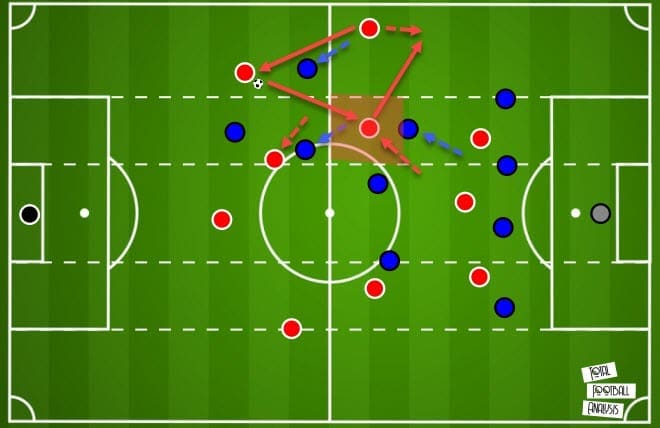
Here, the team in possession goes backwards in order to go forwards, which is the main idea behind negative passing. Since the full-back to the left was initially marked, he decides to pass backwards to his centre-back. This immediately means the opposition have to follow suit if they want to close down the player on the ball. But it also means they start getting out of their compact defensive shape.
The players in red also start moving backwards but now that they are moving away from the opposition’s goal, the defenders are also pulled away with them, creating pockets of space that can be exploited. This then gives another player in red a chance to drop deeper, receive the ball and lay it off back to the full-back who is now unmarked. The red team has successfully gone backwards in order to go forward.
Quique Setién is one of the coaches who knew how to get the most out of this fascinating concept. His Real Betis side was very positional in nature as they often played short combinations with a lot of movement to eventually progress up the pitch. The example below comes from one of Setién’s final days in charge.
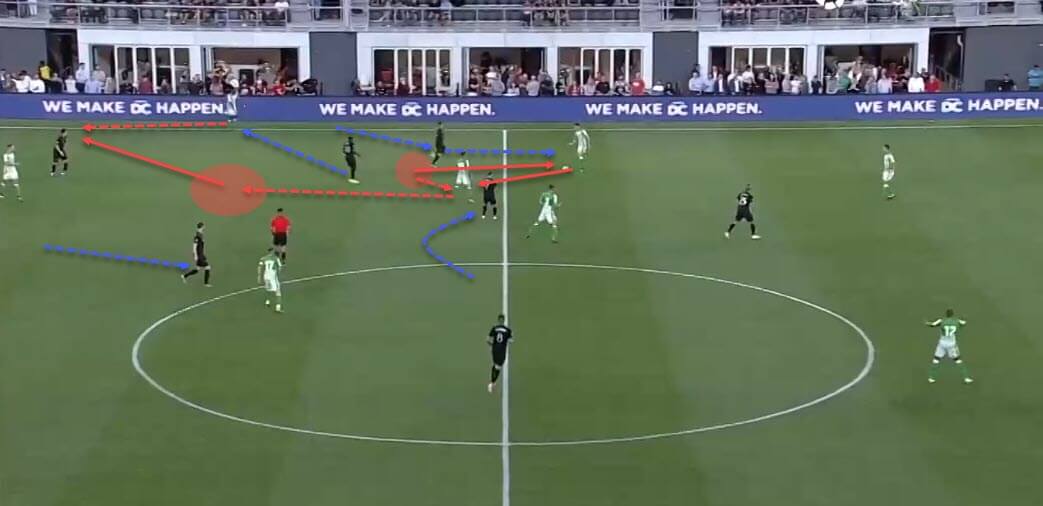
Initially, we see a player pass backwards and immediately reposition himself deeper on the pitch. But this pass backwards has invited the opposition to step forward and press the new ball-carrier, in turn leaving the previous man unmarked on the flank. To plug that hole, the marker who was initially on the player who moved deeper now has to take over the wide man, leaving our initial ball-carrier completely free to receive a pass again.
He then runs with the ball forward and eventually deploys it into space for the full-back to exploit. Just by going backwards with one single pass, Real Betis have unlocked the opposition’s block and opened new channels to achieve progression.
These tactics can also be used to create much higher up the pitch and in the danger areas. The concept remains the same – pass backwards to provoke movement by the opposition and eventually break their initial compact structure.
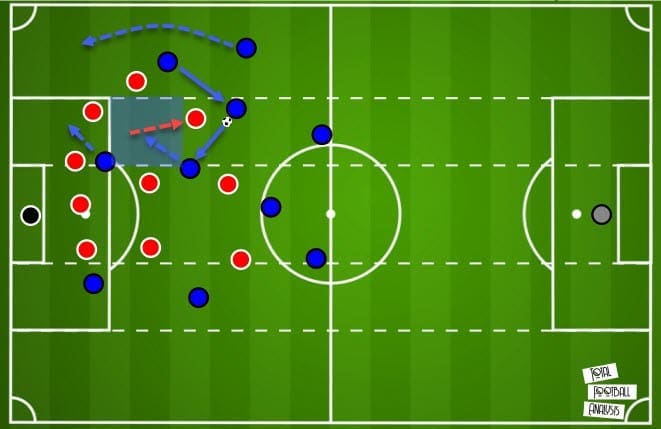
The ball is out wide with a player but due to the full-back still being deep and no viable passing options going forward, the pass goes backwards. However, just as before, this prompts the defenders to step up and challenge for the ball, leaving gaps behind their backs that can be exploited by smart movement.
Once in that small pocket of space, the blue team can combine and orchestrate their attack even further and from a better position. But apart from creating new openings by carving up deep and middle blocks, negative passes are also essential when it comes to bypassing the high press.
Again, the idea is to briefly go backwards in order to go forward once a better channel is found. This is also where the use of a goalkeeper is welcomed, although not always absolutely necessary. But the goalkeeper ensures numerical superiority and puts the opposition into a decisional crisis, thus enhancing the attacking team’s chances of bypassing the press.
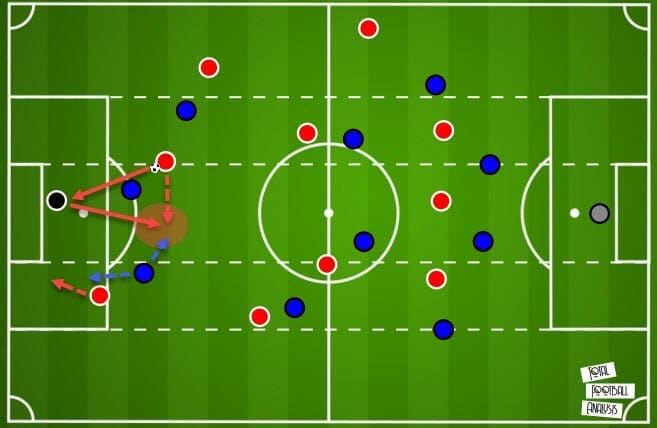
In the graphic above, by going back to the goalkeeper, the team in possession creates a 4v3 situation and puts the left forward in a decisional crisis. Does he press the right centre-back or does he stay with the central man? If executed well, this sequence often results in eventual progression.
The very nature of negative passing means it’s often a pressing trigger for many teams when defending. The same is true in this scenario when playing out of a high-press situation. Juan Carlos Osorio, the former manager of Mexico, is someone who also made use of negative passing’s benefits to his advantage. His team didn’t always have a lot of possession but they were very vertical and direct despite often going backwards as well.
In the image below, we see Mexico escape Germany’s high press by going back to the goalkeeper. The press is activated as soon as the ball is deployed from one of the dropping players.
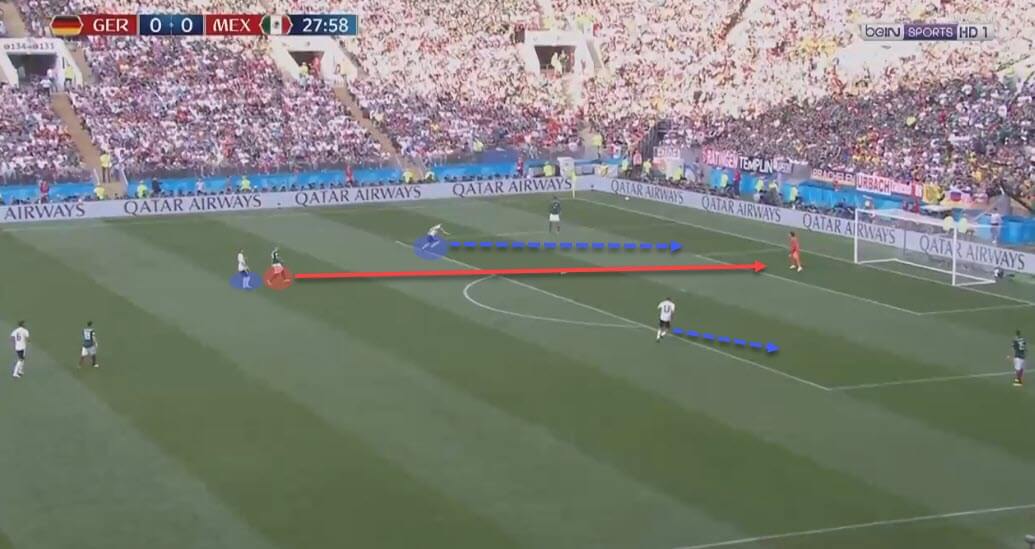
Again, this is a 4v3 situation due to the goalkeeper’s presence. And since that puts the opposition into a decisional crisis, progression is far easier achieved than in normal circumstances higher up the pitch. The player once again isn’t sure who to mark and that’s exactly why he’s caught on the wrong foot and taken out of the equation.
Similarly, because the forward line was pulled much higher on the pitch due to the negative pass, there’s now a lot of space between them and the rest of the team, giving Mexico a chance to advance uncontested.
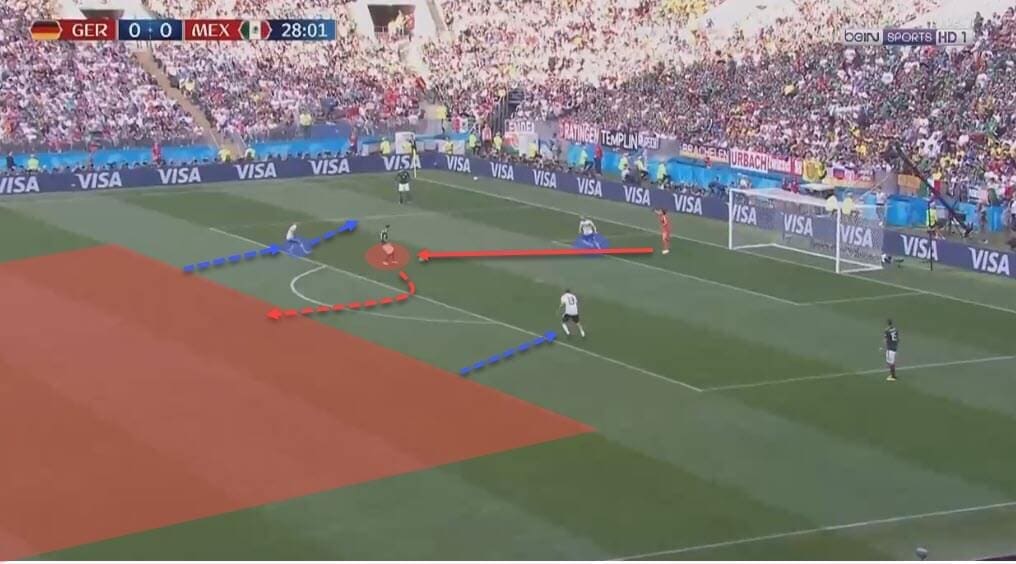
And while going backwards to go forward is the whole theme of this concept, different aspects of it can be applied to these tactics. One such aspect is changing the angle of attack.
Changing the angle of attack
The second benefit of negative passing we’ll discuss in this tactical analysis is changing the angle of attack. But before we move on, it is important to note that all of these aspects are connected and there will be recurring themes throughout. That being said, changing the angle of attack is accomplished with a combination of negative and horizontal passes.
Horizontal passes are somewhat neutral as they are often not grouped within either of the two extremes. However, they are also not positive in their nature so some of the examples in our tactical theory will have a combination of negative and horizontal passes to further solidify the points.
Changing the angle of attack is necessary when going forward gets difficult and the opposition successfully plug all the holes in their block. These tactics are also closely connected to the concept of overload to isolate, which includes quickly changing sides to attack the less-populated area of the pitch.
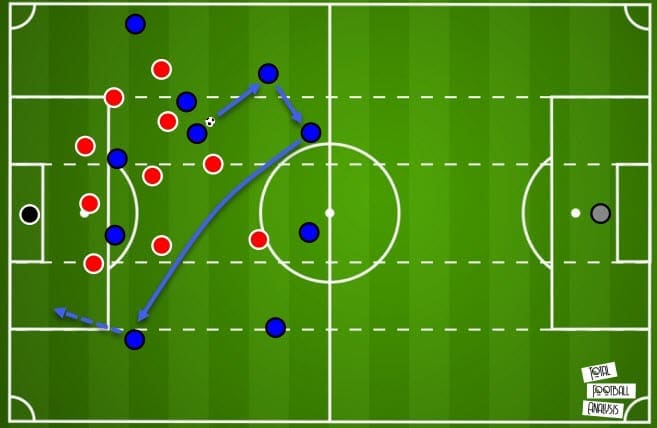
These sequences often start with a negative pass that draws out the opposition and gives the team in possession a moment to restart the attack but with a different angle or through a different route. It’s important to note that changing the angle doesn’t necessarily have to be changing the side of the pitch you attack but there are obvious advantages to that as well.
Some teams like Pep Guardiola’s Manchester City, for example, do it through a combination of both short and long passes and overloading to isolate is a common tactic in their playbook. In the image below, you can see them start a transition from one side to the other by first playing away from the opposition’s goal.
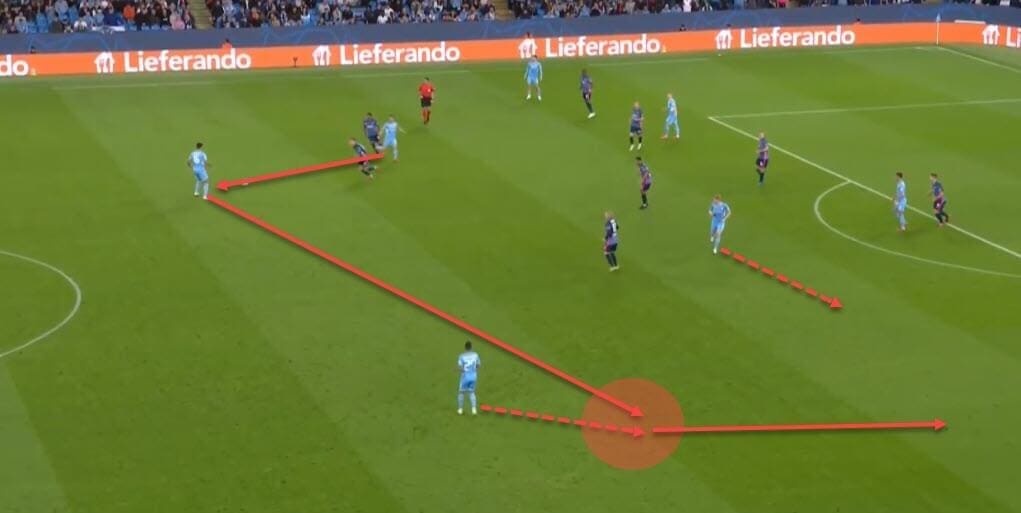
A backwards pass in these situations is often a get-out-of-jail card because a forward pass would’ve likely resulted in a loss of possession. Instead, by going backwards once, Manchester City guarantee retention of possession and eventually progression by changing the angle of their attack and attacking a side or a channel that’s open and not as congested.
But as we’ve already mentioned in this analysis, changing the angle can be far more subtle than passing across the whole width of the pitch. Bayern Munich under Julian Nagelsmann are an excellent example of finding different solutions by resetting the attack and tweaking their channel of progression.
In the example below, you can see them go backwards because the way forward is blocked by Barcelona midfielders.
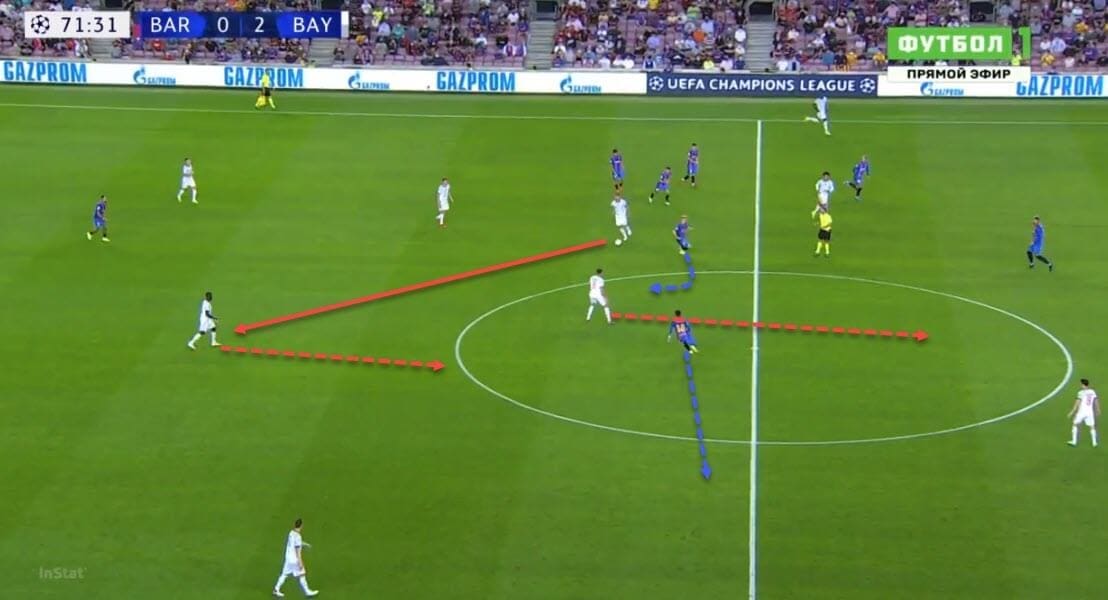
However, this is only a temporary setback and a necessary step to get to the same goal. Going backwards opens up a whole different angle to attack the opposition and involves progressing with the ball from the deep. Again, negative passing doesn’t just dictate where the team in possession goes but it also manipulates the other squad as well.
Here, Barcelona are forced to restructure their block but it’s to no avail since the Bavarians have already identified and exploited their new angle to attack. Notice how a single pass backwards resulted in two vertical passes that put Bayern inside the opposition’s penalty area.
One step backwards, two steps forward.
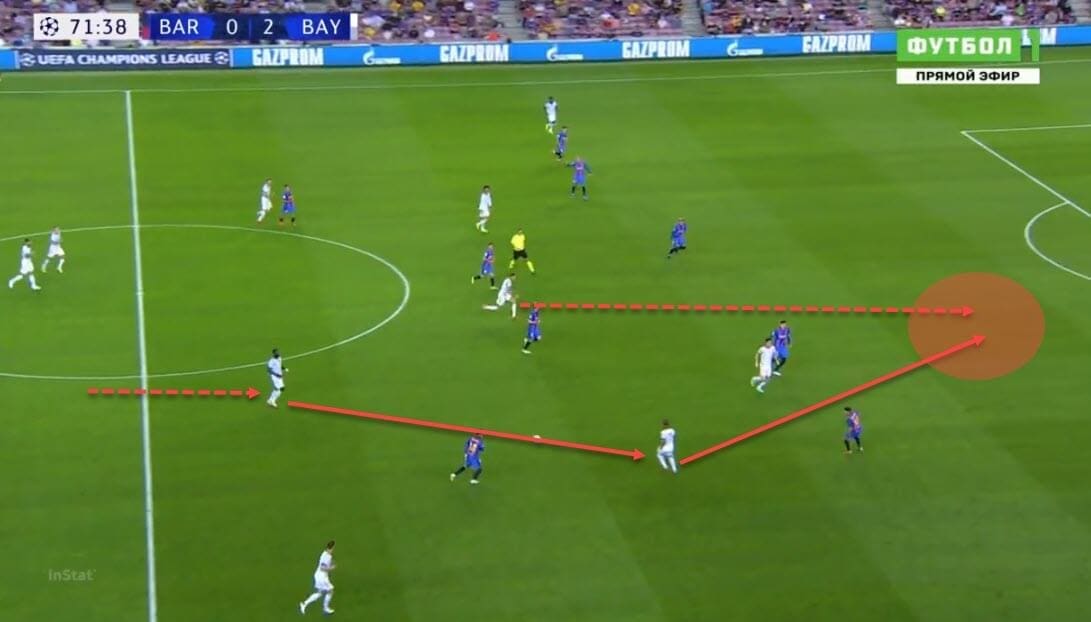
Even though they are on the receiving end of such a sequence in that example against the German titans, Barcelona themselves are very good at reaping the benefits of negative passing. But it’s their golden generation under Guardiola that is perhaps the best example of that.
Between 2009 and 2011, they were the positional team to follow and the early users of these concepts. They knew very well that sometimes, in order to advance closer to your goal, you have to take a step back or in our case, pass backwards.
Below is a good example of that against Espanyol. Barcelona are still masters at recycling possession and waiting for the right opening or simply creating one by exploiting all sorts of different angles. Often, that included looking for one by going backwards, just as is the case in the following image.
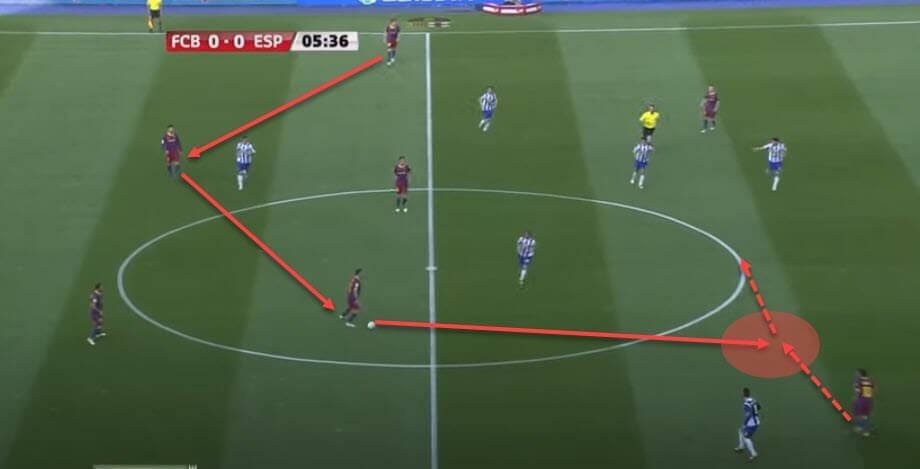
One negative pass is quickly followed by two passes forward as Barcelona find a solution to unlocking Espanyol’s block. Notice how their progression targets on the left were mostly marked and that side of the pitch was heavily populated by opposition players. By tweaking the angle of their attack, they manage to find and exploit gaps that were previously not accessible.
And that, perhaps, is the biggest benefit you can reap from backpassing. However, there’s one final aspect you control if you know how to use negative passing – tempo.
Setting the tempo
The final section of our tactical theory will focus on the analysis of controlling the tempo via negative passing. Tempo is something that’s quite difficult to depict through graphs or images but is still a very important aspect nonetheless. Knowing when to speed up and when to slow down the game is crucial if a team wants to control the proceedings of a game.
Passes forward or positive passes are largely used to accelerate the tempo while negative passing can be seen as a tool to decelerate. Often teams get too tangled up in short and quick combinations that just waiting for better and easier options to open up can be a good alternative.
However, while setting the tempo often means controlling your speed of action, it can also be used to manipulate the opposition’s. Once again we’ll visit Nagelsmann’s Bayern for examples of this.
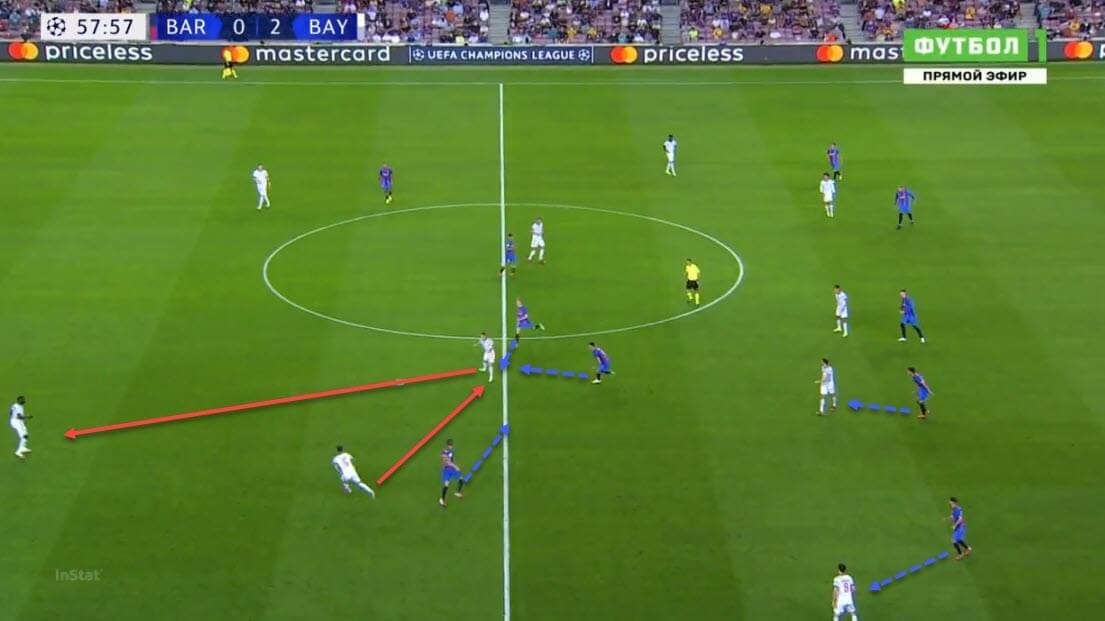
Barcelona are pressing aggressively and Bayern need to slow down the tempo of the game, reassess their options and then advance. To do this, the first pass goes backwards and then the proceedings are slowed down immensely. Barcelona refuse to push up and this gives Bayern time and space to find solutions to break down the defensive block.
Then, once they find a channel to exploit, a vertical pass forward is played and they advance up the pitch and immediately switch gears to speed up the game again. By playing one negative pass, they’ve effectively stopped Barcelona’s collapse and given themselves time to find a more viable move forward.
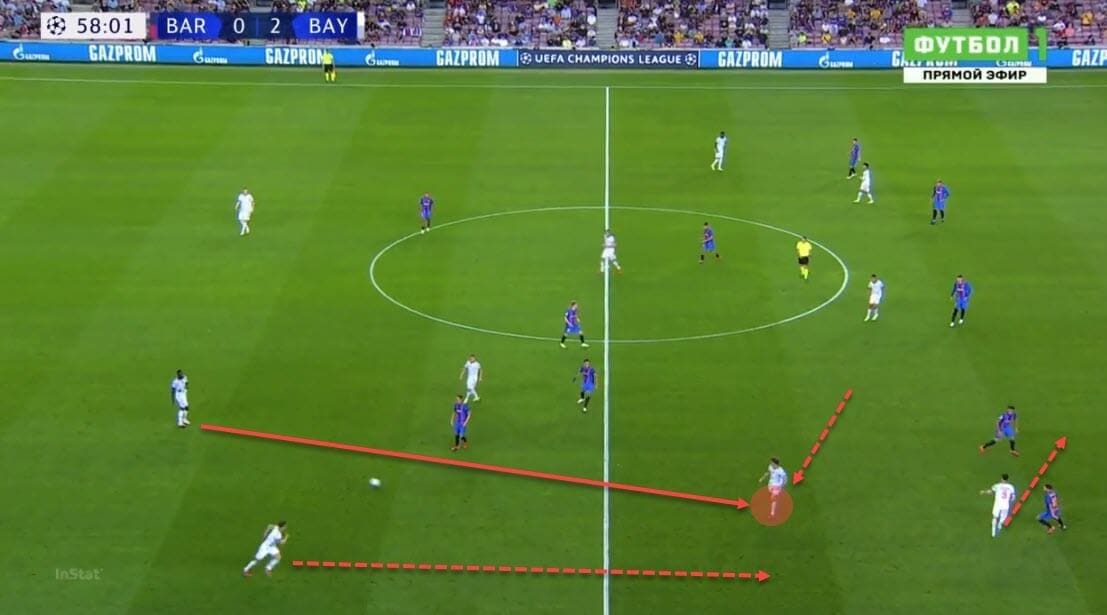
But this is also where we have to mention teams who are excellent at recycling the ball and utilising horizontal passes well. Usually, possession-heavy teams will run into progression problems once facing deep and compact defensive blocks that need to be unlocked. In such situations, ball recycling is very common.
And while many see useless passing for the sake of passing, the tempo can change in an instant. Again we’ll come back to Real Betis’ tactics under Setién. Below, we find them recycling possession in the backline in what seems like an ordinary exchange between centre-backs.
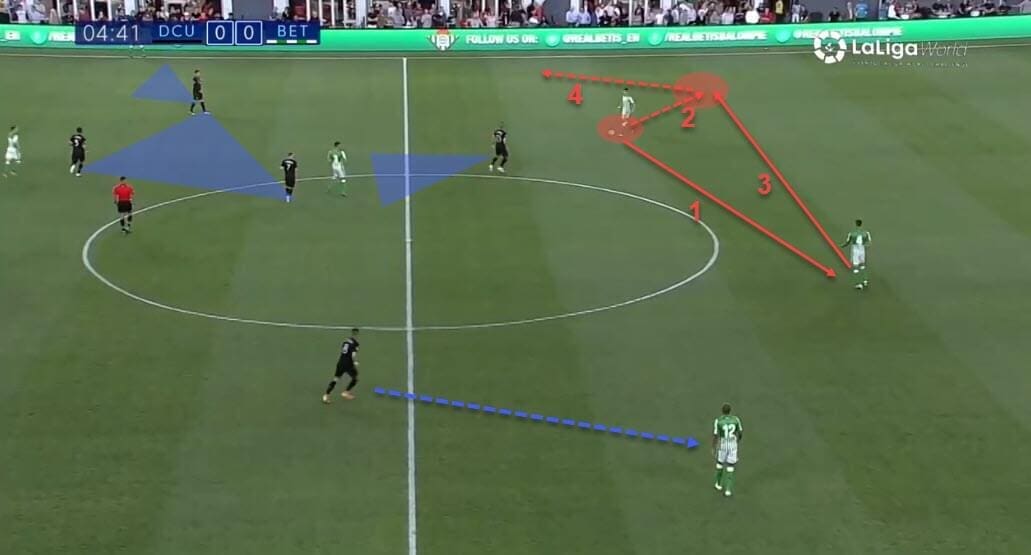
But instead of going forward into a populated area of the pitch, Betis keep the tempo very slow and pass backwards and between the two defenders. This moves the opposition’s block and also opens up different channels that can be exploited once the opportunity arises. The ball then moves back to the player on the right and immediately the change in tempo happens again.
This example is great because it shows us multiple concepts in one sequence – the control of tempo when there’s no option available, changing the angle shortly after and then speeding up the game once the new channel is found.
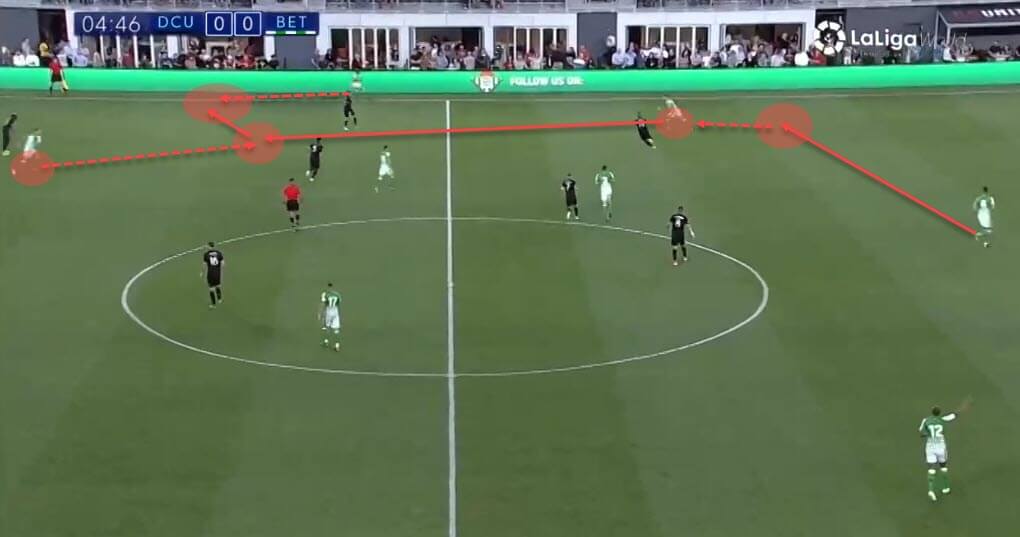
Our final example also comprises multiple aspects or benefits of negative passes. Once again we’ll visit Guardiola’s Barcelona as they are an excellent example of these tactics. At first sight, it’s a very simple exchange between Sergio Busquets and Lionel Messi but it utilises movement manipulation, changing the angle and alteration of tempo extremely well.
We see Messi running with the ball centrally and then sending a negative pass towards Busquets. This immediately draws the attention of the defenders who turn towards the new ball-carrier and completely disregard the area Messi is attempting to access.
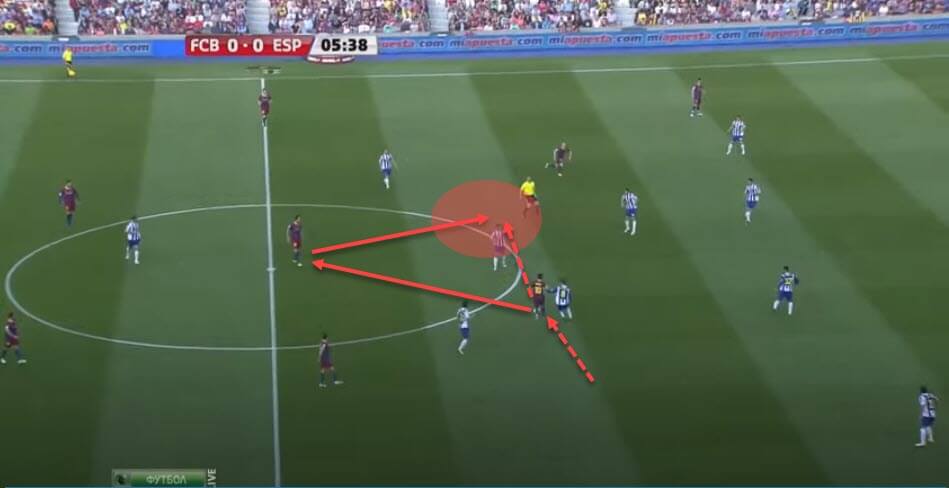
The negative pass starts the quick change of tempo and opens up new channels to access the target area. Busquets follows up with another fairly simple pass forward, finding Messi in a far dangerous section of the pitch.
Note that this was previously unaccessible and only a pass backwards made it possible for Barcelona to ultimately advance up the pitch and through Espanyol’s defensive block.
Final remarks
Negative passing is largely seen as exactly that – ‘negative’. But going backwards is sometimes necessary if the team wants to go forward. Some of the clearest benefits of negative passes were explained in this tactical analysis but that’s also just scratching the surface of a very complex aspect of the beautiful game.
The best teams and coaches are aware of how effective they can be if used correctly. As ever, it’s all how we use the tools that are available to us and negative passes should be just that – one of the tools to gain an advantage in a game of football.






Comments